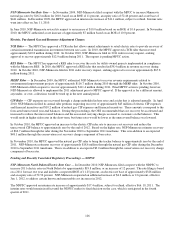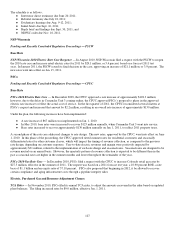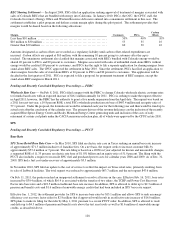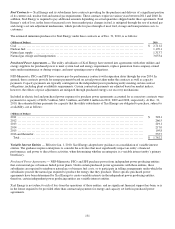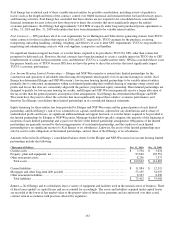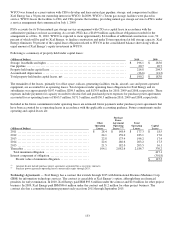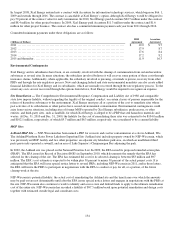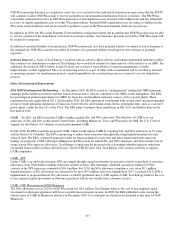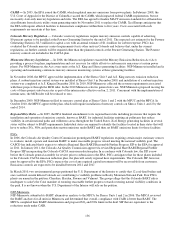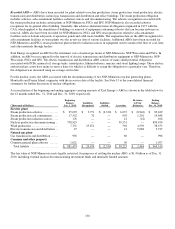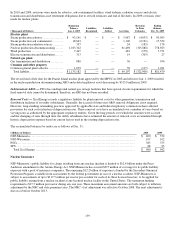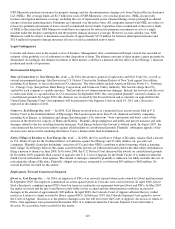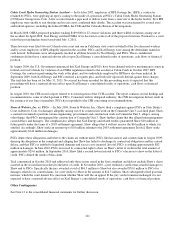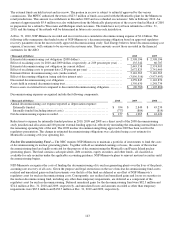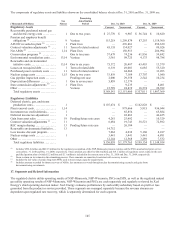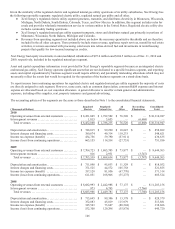Xcel Energy 2010 Annual Report Download - page 146
Download and view the complete annual report
Please find page 146 of the 2010 Xcel Energy annual report below. You can navigate through the pages in the report by either clicking on the pages listed below, or by using the keyword search tool below to find specific information within the annual report.
136
CAMR — In 2005, the EPA issued the CAMR, which regulated mercury emissions from power plants. In February 2008, the
U.S. Court of Appeals for the District of Columbia vacated the CAMR, which impacted federal CAMR requirements, but not
necessarily state-only mercury legislation and rules. The EPA has agreed to finalize MACT emission standards for all hazardous
air pollutants from electric utility steam generating units by November 2011 to replace the CAMR. Xcel Energy anticipates that
the EPA will require affected facilities to demonstrate compliance within three to five years. Costs associated with such
requirements are uncertain at this time.
Colorado Mercury Regulation — Colorado’s mercury regulations require mercury emission controls capable of achieving
80 percent capture to be installed at the Pawnee Generating Station by the end of 2011. The expected cost estimate for the Pawnee
Generating Station is $2.3 million for capital costs with an annual estimate of $1.4 million for sorbent expense. PSCo has
evaluated the Colorado mercury control requirements for its other units in Colorado and believes that, under the current
regulations, no further controls will be required other than the planned controls at the Pawnee Generating Station. The Pawnee
mercury controls are included in the CACJA plan.
Minnesota Mercury Legislation — In 2006, the Minnesota legislature enacted the Mercury Emissions Reduction Act (Act)
providing a process for plans, implementation and cost recovery for utility efforts to curb mercury emissions at certain power
plants. For NSP-Minnesota, the Act covers units at the A.S. King and Sherco generating facilities. NSP-Minnesota installed and is
operating and maintaining continuous mercury emission monitoring systems at these generating facilities.
In November 2008, the MPUC approved the implementation of the Sherco Unit 3 and A.S. King mercury emission reduction
plans. A sorbent injection control system was installed at Sherco Unit 3 in December 2009, and installation of a sorbent injection
system was completed at A.S. King in December 2010. In 2010, NSP-Minnesota collected the revenue requirements associated
with these projects through the MCR rider. In the 2010 Minnesota electric general rate case, NSP-Minnesota proposed moving the
costs of these projects into base rates as part of the interim rates effective on Jan. 2, 2011. Concurrent with the implementation of
interim rates, the MCR rider will be reduced to zero.
In December 2009, NSP-Minnesota filed its mercury control plan at Sherco Units 1 and 2 with the MPUC and the MPCA. In
October 2010, the MPUC approved the plan, which will require installation of mercury controls on Sherco Units 1 and 2 by the
end of 2014.
Regional Haze Rules — In 2005, the EPA finalized amendments to its regional haze rules including provisions that require the
installation and operation of emission controls, known as BART, for industrial facilities emitting air pollutants that reduce
visibility in certain national parks and wilderness areas throughout the United States. Xcel Energy generating facilities in several
states will be subject to BART requirements. Individual states are required to identify the facilities located in their states that will
have to reduce SO2, NOx and particulate matter emissions under BART and then set BART emissions limits for those facilities.
PSCo
In 2006, the Colorado Air Quality Control Commission promulgated BART regulations requiring certain major stationary sources
to evaluate, install, operate and maintain BART to make reasonable progress toward meeting the national visibility goal. The
CAPCD has indicated that it expects to submit a Regional Haze BART/Reasonable Further Progress SIP to the EPA for approval
in 2011. In January 2011, the Colorado Air Quality Commission approved a revised Regional Haze BART/Regional Further
Progress SIP incorporating the Colorado CACJA emission reduction plan. In accordance with Colorado law, the SIP is now
before the Colorado general assembly for review prior to submission to the EPA. PSCo anticipates that for those plants included
in the Colorado CACJA emission reduction plan, the plan will satisfy regional haze requirements. The Colorado SIP, however,
must be approved by the EPA. PSCo expects the cost of any required capital investment will be recoverable from customers.
Emissions controls are expected to be installed between 2012 and 2017.
In March 2010, two environmental groups petitioned the U.S. Department of the Interior to certify that 12 coal-fired boilers and
one coal-fired cement kiln in Colorado are contributing to visibility problems in Rocky Mountain National Park. Four PSCo
plants are named in the petition: Cherokee, Hayden, Pawnee and Valmont. The groups allege that the Colorado BART rule is
inadequate to satisfy the CAA mandate of ensuring reasonable further progress towards restoring natural visibility conditions in
the park. It is not known when the U.S. Department of the Interior will rule on the petition.
NSP-Minnesota
NSP-Minnesota submitted its BART alternatives analysis to the MPCA for Sherco Units 1 and 2 in 2006. The MPCA reviewed
the BART analyses for all units in Minnesota and determined that overall, compliance with CAIR is better than BART. The
MPCA completed their BART determination and proposed SO2 and NOx limits in the draft SIP that are equivalent to the
reductions made under CAIR.


